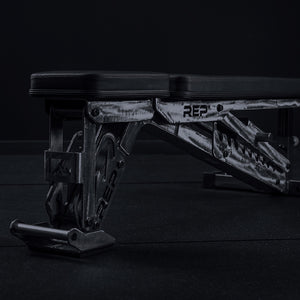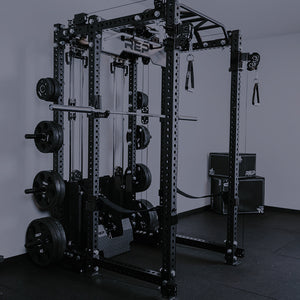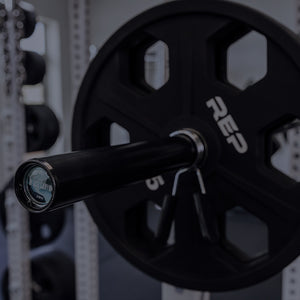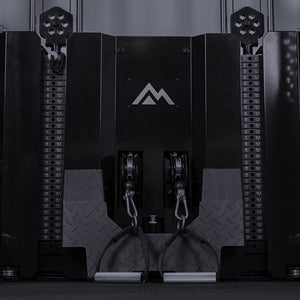
Swing them, lift them, carry them from one wall to another — kettlebells are a versatile tool that can help you build strength, coordination, power, and improve your cardiovascular health.
We tapped kettlebell savant Zack Whitmer on everything there is to know about this tool and exactly why he recommends it.
Q&A with a Certified Kettlebell Instructor
Zach Whitmer runs one of Northern Colorado’s most respected gyms, Pursuit Training Center. He has a background in competitive powerlifting. He lost 130 pounds after more than a decade of being morbidly obese. And he owes it all to swinging and slanging through a variety of kettlebell exercises. The simple yet incredibly versatile kettlebell was the seed that started it all.
It’s no surprise that Whitmer’s IG name is Kettlebell_Chaos.fit. It’s also fitting that a rack of REP® kettlebells is the first thing you see when you step inside his gym. Whitmer is a StrongFirst certified kettlebell instructor (basically the Harvard of kettlebell education); he teaches and facilitates kettlebell classes at Pursuit; and he’s gearing up to launch a new kettlebell-focused strength program on Train Heroic.
We wanted to dig deeper into his vast kettlebell knowledge — from the best kettlebell core exercises to the benefits of kettlebell swings — so we sat down with him and asked him All Of The Questions. Here’s how it went down.

Zack Whitmer. Photo by Gabby Jagoras
How did you first start slanging kettlebells?
I was morbidly obese for 12 years after playing football. When I moved to Colorado from LA in 2013, a neighbor was a CrossFit coach. That was my intro into getting in shape and being around a community of people working toward the same goal.
From there, I got into powerlifting. I went to a seminar with Chris Duffin. The first tool he grabbed was a kettlebell. I wondered, “We’re at a powerlifting seminar. Why is this guy messing with a kettlebell?” But when we started implementing it, I realized how great of a tool it was. I fell in love with using it.
How did kettlebells help you lose 130 pounds?
I was still powerlifting, but 70 percent of my work was all kettlebells. I liked the crossover of strength and also endurance – the cardio component. If you’re doing ‘hardstyle’ kettlebell training [a style of training centered around tension and power], it’s explosive, fast, ballistic movements, building those fast-twitch fibers. So you’re building strength at the same time as endurance.
What was it about kettlebells that you liked so much?
Personally, I get bored training. When I’m grinding through an eight- to 12-week powerlifting program, by week six, I’m struggling to finish the program because I’m so bored and want to mix things up.
A kettlebell is so multifunctional. In addition to hardstyle movements, I specialize in kettlebell flow: just moving with the kettlebell, like if karate and kettlebells had a baby. There’s a lot of free movement and fun stuff, like flipping the kettlebell and moving in ways you normally wouldn’t train.
How would you recommend incorporating kettlebells into a home gym?
When people think of a home gym, they immediately think they need a set of dumbbells, but that’s not necessarily true. If you had a 12, 16, 20, and 24kg kettlebell, you could build a very successful program. Start low and work your way up. That’s the dream home set in my head.
If you want to get crazy with it, in the hardstyle kettlebell world, women have to test and pass a certain series of exercises with a 16kg and men with a 24kg.
[Read More: Kettlebell vs. Dumbbell]
What are the hardstyle exercises?
There are six exercises that cover nearly all muscle groups. The ballistic movements are the Russian swing, swing clean, and swing snatch. The heavier, grinding movements are overhead press, goblet squat, and Turkish getup.
The only thing missing is a chest movement, so I’d add a kettlebell floor press into that to get more chest work in. You could incorporate deficit push-ups on the kettlebell, too.
What are the biggest mistakes you see people make when using kettlebells?
The No. 1 thing you hear is ‘I don’t want to hurt my back.’ If you think about the movements, most of the time, the kettlebell weight is loaded in front of you and the only thing saving your back is creating proper core tension. So any time you’re going through the movements, really focus on core tension – engaging the core and breathing through it. That’ll help protect your back.
The other issue is the swing. The Russian kettlebell swing is the traditional swing [a swing up to chest or eye level]. CrossFit has popularized an American swing that goes overhead – but people aren’t doing it properly because they’re abandoning the backbone of the kettlebell swing, which is the hinge. They’re turning it more into a squat, which puts tension on people’s backs. First, you gotta learn how to properly do a true Russian kettlebell swing.
What are the main cues you give people for a Russian kettlebell swing?
- It’s a hinge: butt back, chest down. Don’t be afraid to being the chest parallel to the floor.
- When coming through your hips at the bottom of the hinge, keep it tight to your hips at the bottom.
- At the top of the swing, lock your hips and knees and squeeze your core.
Any advice for people who want to do an American swing?
Be careful, because when the kettlebell swings up and hits the top of your shoulder, what makes it stop? Your joints. Your shoulder gets pulled back behind your head in an unsafe fashion. Instead, hit the hinge and on the way up, pull it straight up to the sky, rather than a pendulum movement that yanks your joints backward. Punch through the top, so the momentum moves up, not back.
Kettlebell Swing Muscles Worked:
The kettlebell swing targets the glutes, hamstrings, calves, erector spinae, traps, rhomboids, and grip. If you've got 30 minutes, try this full-body kettlebell workout.
Any other advice for people looking to incorporate a kettlebell into their training?
If you’re just getting started in fitness, it’s a safe, effective way to get in shape. But you can take it as far as you want. I know people jacked out of their minds who only train with kettlebells. Overall, though, to learn the kettlebell takes great technique. So, not only are you getting stronger and improving your endurance, you’re also learning a trade: something that is technical and fun to learn. It wraps everything into one small package.
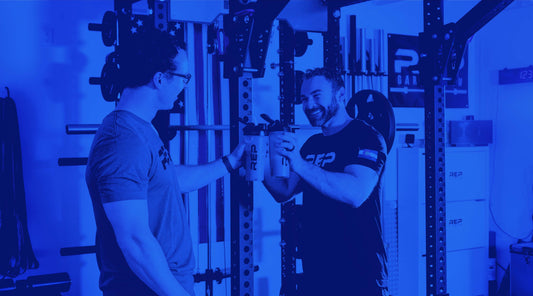
NEWSLETTER SIGNUP
Product launch information, promotions, blogs, and REP news.

